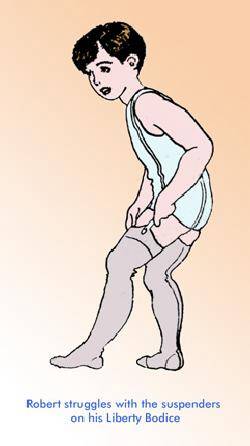
English Boys Garments: Underwear

Figure 1.-- A reader found this illustration in a London junk shop somewhere among some sheets
showing "vintage" British children's clothes. Unfortunately we don't know the source or the date. I think it probably depicts a boy from around 1920-25, and probably comes from some more modern work (maybe from the 1950s or 1960s)illustrating "old-fashioned" British clothes. But this
is just a guess. Without this unformation it is a little difficulkt to assess the image.
The boy is wearing a Liberty Bodice (as interesting evidence that boys did wear the garment) but with
reservations about the dating and frequency of its use for boys. A slightly puzzling feature of this illustration is that the Liberty Bodice in this case has the garters already built in and attached
whereas most of our other historical evidence suggests that garters were purchased separately and attached by buttons to a tape strip at the bottom. The built-in garters would seem to suggest a somewhat more modern garment. I base this assumption on the analagous German Leibchen, shown, for instance, in the film Aimee & Jaguar (set in World War II Berlin).
|
|
We do not have much information on English underwear at this time. HBC relies heavily on period photography and this does bot tell us a great deal about underwear. We note children wearing combinations in the late 18th and early 19th centuries. We do not know how common they were. We also notice younger children wearing pantalettes in he mid-19th century. English underwear terms are different than American terms. The common union suits worm in the late 19th and early 20th centuries were called cominations in Britain. Underpants are referred to as just pants. Actual outergarments are referred to as trousers, never pants. Girls underpants are called knickers, a term one used for short pnts as well. Long stocking were not as common in England during the 20th century as in America and several European countries, but they were worn. The common stocking supporter garment or waist was called a Liberty bodice. Gender variations have differed. There was obviously boys and girls underwear, but at times the underwear for younger children has been fairly standard.
Limited Information
We do not have much information on English underwear at this time. HBC relies heavily on period photography and this does bot tell us a great deal about underwear. For America we have readily available mailorder catalogs for reference. There were also catalogs in Britain, although not as many with as detailed offerings. We do not, however, have access to British catalogs and thus our information is limited.
Chronology
Garments
We note children wearing combinations in the late 18th and early 19th centuries. A good example is the combination undewear suit made for Ambrose Turner by his mother about 1839. We do not know how common they were. We also notice younger children wearing pantalettes in he mid-19th century. We are not sure about underwear garments in the early 20th century. As far as we can tell, the garments worn after World war II were similar to those worn in America.
Vocabulary
English underwear terms are commonly different than American terms. There are differences in outwear as well, but the differences for some reason are most pronounced with underwear. The common union suits worm in the late-19th and early 20th centuries were called cominations in Britain. Undershirts wre call vests. This is a term Americans now used for waistcoats, but I think in the early 20th century was also used for undershiryts, I think the single type. Underpants are referred to as just pants. In America, pants are another word for trousers. Actual outergarments in Britain are referred to as trousers, never just pants. Girls underpants are called knickers, a term once used for short pants as well and in America always used for outerwear.
Stocking Supporters
Hosiery and undrwear were related in the late 19th and early 20th centuries. Long stocking were not as common in England during the 20th century as in America and several European countries, but they were worn. The common stocking supporter garment or waist was called a Liberty bodice.
Gender variations in underwear have differed over time. We do not have a great deal of information on this, but believe that the overall trends were similar to those in America. There was obviously boys and girls underwear, but at times the underwear for younger children has been fairly standard. There were girls underwear with frills, but many mothers in th 19th and early 20th centuries purchased the basic underwear for everyday wear that both boys and girls wore. This became much less common, especially after World War II.
HBC

Navigate the Boys' Historical Clothing Web Site:
[Return to Main English garment page]
[Return to Main getting country dressed page]
[Introduction]
[Activities]
[Biographies]
[Chronology]
[Clothing styles]
[Countries]
[Photography]
[Topics]
[Bibliographies]
[Contributions]
[FAQs]
[Glossaries]
[Images]
[Links]
[Registration]
[Tools]
[Boys' Clothing Home]
Created: 8:56 PM 9/7/2006
Last updated: 5:29 PM 6/12/2008



